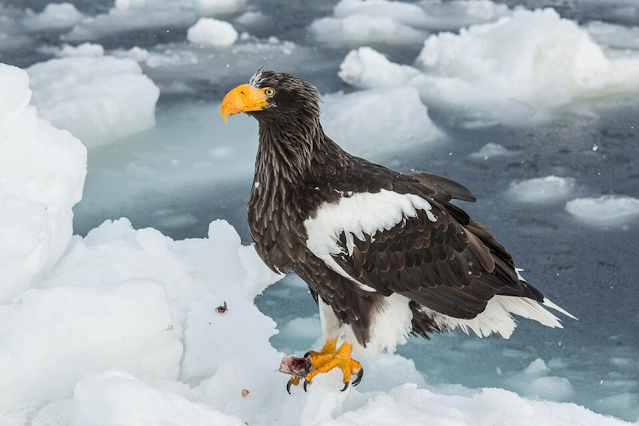Steller’s Sea Eagle – The Giant Raptor of the North Pacific
Introduction
The Steller’s Sea Eagle (Haliaeetus pelagicus) is a majestic and powerful bird of prey native to northeastern Asia. Known for its massive size, bold coloring, and fierce hunting skills, this eagle is one of the largest and rarest sea eagles in the world.
Often called the "King of Eagles," the Steller’s Sea Eagle is a symbol of strength and endurance in the cold and harsh landscapes where it thrives.
Taxonomy and Classification
- Kingdom: Animalia
- Phylum: Chordata
- Class: Aves
- Order: Accipitriformes
- Family: Accipitridae
- Genus: Haliaeetus
- Species: H. pelagicus
It belongs to the same genus as the Bald Eagle and White-tailed Eagle, making it part of a group known as sea eagles or fish eagles.
| Feature | Description |
|---|---|
| Wingspan | 2.2 – 2.5 meters (7.2 – 8.2 feet) |
| Body Length | 85 – 105 cm (33 – 41 inches) |
| Weight | 6.8 – 9 kg (15 – 20 lbs) |
| Beak | Massive, bright yellow, strongly hooked |
| Coloration | Dark brown body, contrasting white tail, shoulders, and thighs |
| Lifespan | 20 – 25 years in the wild, longer in captivity |
Geographic Range and Habitat
Native Range:
- Eastern Russia (Kamchatka Peninsula)
- Sea of Okhotsk
- Sakhalin Island
- Hokkaido, Japan (in winter)
Habitat:
- Coastal cliffs
- Forested rivers
- Sea coasts
- Ice-covered lakes in winter
It prefers coastal areas where fish and open water are abundant, especially during breeding and feeding seasons.
Diet and Hunting Strategies
Steller’s Sea Eagle is a carnivorous apex predator, primarily feeding on fish but also hunting birds and small mammals.
Primary Diet:
- Salmon (Pacific and pink varieties)
- Trout and cod
- Waterfowl and gulls
- Occasionally: hares, foxes, and carrion
Hunting Techniques:
- Perches on high cliffs or trees to spot prey
- Executes powerful swoops to snatch fish with strong talons
- Sometimes steals food from other birds (kleptoparasitism)
Its enormous beak and talons allow it to tear apart even large prey with ease.
Breeding and Lifecycle
Breeding Season:
- Begins in March or April
Nesting:
- Massive nests built with sticks
- Usually located in tall trees or cliff edges
Eggs and Incubation:
- Lays 1 to 3 eggs
- Incubation: 35 – 45 days
- Only 1 chick typically survives to fledge
Juvenile Stage:
- Chicks fledge at 10 – 12 weeks
- Remain dependent on parents for several months
- Reach maturity around 4 – 5 years of age
Steller’s Sea Eagles are monogamous and often return to the same nest site year after year.
Behavior and Vocalization
Behavior:
- Solitary or in pairs
- May gather in groups near abundant food sources like salmon runs
- Territorial during breeding season
Vocalization:
- Harsh, barking call: "kra-kra-kra"
- Used to communicate between mates or warn intruders
- Not as melodious as songbirds, but very distinctive
These eagles are highly alert and aggressive when threatened, often chasing off other predators or humans.
Conservation Status and Threats
IUCN Red List: Vulnerable
Estimated Population: Around 5,000 individuals
Threats:
- Habitat loss due to logging and development
- Pollution (especially oil spills)
- Climate change affecting salmon populations
- Illegal hunting and poaching
Conservation Efforts:
- Protected under CITES Appendix II
- Strict hunting bans in Russia and Japan
- Captive breeding and reintroduction efforts
- Public awareness and eco-tourism supporting conservation
Despite efforts, the population remains small, making every breeding pair crucial for the species’ survival.
Cultural Significance and Symbolism
In Russian and Ainu cultures (indigenous people of Japan), the Steller’s Sea Eagle is seen as a symbol of power and freedom.
It also appears on:
- Postage stamps of Russia and Japan
- National conservation emblems
- Bird-watching tourism campaigns in Hokkaido
Their presence is considered a sign of a healthy aquatic ecosystem.
Fascinating Facts
- Named after Georg Wilhelm Steller, an 18th-century German naturalist
- One of the few eagles to be regularly sighted in snow
- Occasionally spotted in Alaska and North America due to rare vagrancy
- Has a bite force strong enough to crush bone
- Their yellow eyes help spot fish from vast distances
- Lives in some of the coldest eagle habitats on Earth
🔗 Internal Linking Suggestions
Harpy Eagle: The Apex Predator .......
Cassowary – The World’s Most Dangerous Bird
Conclusion
The Steller’s Sea Eagle stands as one of nature's most awe-inspiring raptors, dominating its northern territory with power and poise. Its rarity and striking appearance make it a favorite among birdwatchers and conservationists alike.
Protecting the habitats of these magnificent eagles is essential to ensuring that future generations can witness their grandeur soaring across the icy skies of the North Pacific.














0 Comments